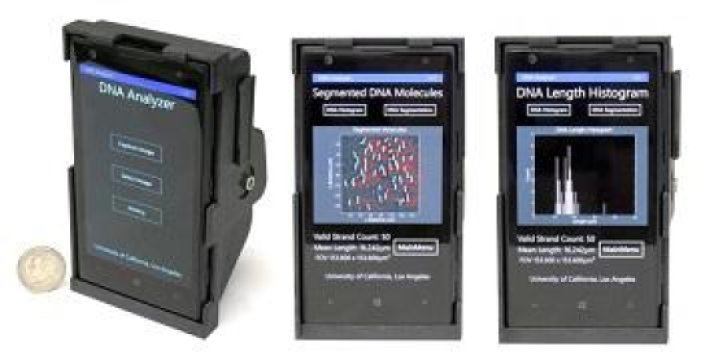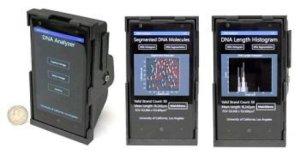

Smartphones are everywhere, and the apps that run on them never cease to amaze. It seems that everything (from fitness trackers to GPS monitoring to cosmic ray detectors) has been released for smartphones in recent years, advancing your phone to near Star Trek-levels of functionality.
Now, researchers at the University of California, Los Angeles (UCLA) have gone full-on tricorder with smartphone apps. Their latest innovation is an attachable device which can turn any smartphone into a DNA-scanning fluorescent microscope.
The attachment slips onto the back of the phone and consists of an external magnifying lens, a laser diode, an interference filter, and a miniature dovetail stage mount. With the attachment in place, the phone becomes a portable fluorescence microscope capable of imaging structures as tiny as a single DNA molecule.
Smartphone-attached microscopes have been on the scene for a while, but previous models were limited to larger-scale objects such as cells. This device, like the others, makes use of the smartphone’s built-in camera to work with the magnifying attachment to produce an enhanced image of the microscopic structures.
Moreover, the cost is entirely manageable. Previous smartphone microscopes have become as inexpensive as $10 to make, and this device should continue that trend. Although it is not available for purchase, the attachment can be printed on a 3D printer, which should keep costs relatively low. This is an amazing breakthrough for areas that lack access to basic medical technology. Now, doctors can carry part of their lab in their pocket.
The UCLA device works with an app which transmits the scanned camera image back to a remote server, which measures the length of the DNA molecules. The data processing portion of the process can be completed in less than ten seconds.
The process is not entirely point and click, however. The slides must be prepared by standard laboratory processes to isolate and label the DNA with fluorescent tags. But those procedures, according to the team, are relatively simple and possible even in remote and resource-limited locations.
As previously mentioned, the device was not actually intended for home use. Instead, the team hopes that it can be used in remote locations where advanced laboratory processing is not available. This could allow advanced diagnostic procedures to occur in the field, resulting in a much faster turnaround than current processes which require physical samples to be transported to correctly equipped laboratories. Initial uses might include diagnosis of various forms of cancer and nervous system disorders such as Alzheimer’s.
The group next plans to test the device in the field detecting malaria-related drug resistance.
From Quarks to Quasars is two people, Jaime and Jolene. We want to make the world a more sciencey place. We’re doing that, but with your help, we can do even more.
FQTQ takes a lot of time, money, and effort. Here, you can support us, get to know us, and access extra content: